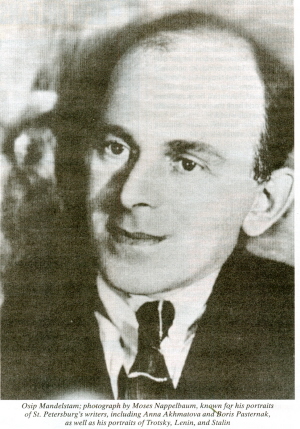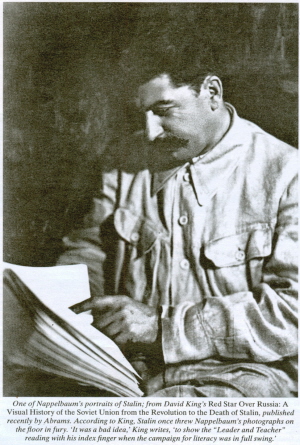Osip
Mandelstam; photograph
by Moses Nappelbaum, known for his portraits of St. Petersburg's
writers,
including Anna Akhmatova and Boris Pasternak, as well as his portraits
of
Trotsky, Lenin, and Stalin
One of
Nappelbaum's portraits
of Stalin; from David King's Red Star Over Russia: A Visual History of
the Soviet Union from the Revolution
to the Death of Stalin,
published recently by Abrams. According to King, Stalin once threw
Nappelbaum's
photographs on the floor in fury. 'It was a bad idea,' King writes, 'to
show
the" Leader and Teacher" reading with his index finger when the
campaign for literacy was in full swing.'
NYRB
June 10, 2010
Reading Mandelstam on Stalin
José Manuel Prieto
EPIGRAM
AGAINST STALIN
We live
without feeling the country beneath our feet,
our words are inaudible from
ten steps away.
Any conversation, however
brief,
gravitates, gratingly, toward the Kremlin's mountain man.
His greasy fingers are thick
as worms,
his words weighty hammers
slamming their target.
His cockroach moustache seems
to snicker,
and the shafts of his
high-topped boots gleam.
Amid a
rabble of
scrawny-necked chieftains,
he toys with the favors of
such homunculi.
One hisses, the other mewls,
one groans, the other weeps;
he prowls thunderously among
them, showering them with scorn.
Forging decree after decree,
like horseshoes,
he pitches one to the belly,
another to the forehead,
a third to the eyebrow, a
fourth in the eye.
Every
execution is a carnival
that fills his broad Ossetian chest with delight.
-Translated
by Esther Allen
from Jose Manuel Prieto's Spanish version*
*The
Russian and Spanish texts
of the poem appear online at www.nybooks .com.
Strongman
MICHA
LAZARUS
đọc
Robert
Littell
THE STALIN EPIGRAM
304pp. Duckworth Overlook.
£14.99. 9780715639030
In November 1933,
Osip Mandelstam composed what would become known as "The Stalin
Epigram", a sixteen-line poem openly critical of the "Kremlin
mountaineer", the "murderer and peasant-slayer", Joseph Stalin.
In May 1934, Mandelstam was arrested for "countertenor activity" and
interrogated for two weeks, but was miraculously spared execution or
imprisonment following an edict from on high to "isolate and
preserve". He and his wife, Nadezhda, spent three years sentenced to
exile
from major cities, and lived peripatetically among friends and around Moscow
for a further year on their return. In May 1938, however, Osip was
arrested
once more, and sentenced to a camp for five years. Shipped to Vladivostok,
he was able to send a single note to his brother requesting "proper
clothes"; he did not survive the winter. Nadezhda outlived him by
forty-two years, eventually reconstituting much of his poetry from
memory.
Such details became known in the West largely thanks to Nadezhda's
magnificent
memoir, Hope Against Hope (1970). An admirer of that book, Robert
Littell met
Mrs Mandelstam in 1979, towards the end of her life, a meeting he
describes in
the epilogue to The Stalin Epigram. The novel reconstructs the events
of the
four years from Mandelstam's composition of the "epigram" to his
death by means of a fictionalized· version of the contemporary voices
of Osip
and Nadezhda and their close friends Anna Akhmatova and Boris
Pasternak, and
the wholly fictional voices of Stalin's chief bodyguard, a beautiful
young
actress connected to the Mandelstam, and a sweet-natured weightlifting
champion
and circus strongman whose experiences of Stalinist criminal justice
are
compared to those of the highly strung and sensitive Osip.
Most of the story takes place around the time of Mandelstam's first
arrest. The
couple's poetic creativity and sexual liberality are set against the
destructive and repressive Soviet bureaucracy, driven by a Stalin who
is more
physically decayed each time he appears. Littell doesn't stray far from
the
memoirs: his embroidery adds color and pace to a story much of whose
imperturbable horror derives from the banality of the state machinery.
Color and pace, however, oddly lessen that horror. In order to
translate from
memoir to novel, Littell situates at the thematic centre of the novel a
conflict between the sword and the pen, Stalin's steel mortality and
Mandelstam's poetic immortality.
The connection between the two, who in reality never met, is elaborated
in
fictional sequences of half-lucid delusions experienced by Mandelstam
under
duress. This is all very well for a story familiarly structured around
agency
and personality, protagonist, antagonist, tragic arc and fatal flaw; as
such,
Littell' s version is a swift and engaging piece of fiction. But the
macabre
pressure of the times is lifted in his account, as the bureaucratic
impersonality of events is transformed into a straightforward battle of
wills.
The novel thus squanders the opportunity offered by historical fiction
to
vivify the past and populate its silences. The "voices" here shift
uncomfortably between intimacy and expository formality, and sound
artificial;
the fictional characters imaginatively recreate the events from
multiple
perspectives, but (with the exception of Fikrit, the strongman) are too
typical
to add much. "You have to have lived through the thirties to
understand",
says Akhmatova in the novel, "and even then you don't understand."
Perhaps this is true, although Nadezhda Mandelstam's retelling was both
incisive and articulate. The Stalin Epigram is an entertaining,
well-researched
introduction, but the real story is in the memoirs.
TLS June 4 2010
Robert
Littell chuyển bài thơ “Vịnh Stalin” (1)
thành tiểu thuyết.
(1)
THE STALIN EPIGRAM
Mandelstam's
poem on Stalin
(November 1933) (1)
We
live, deaf to the land
beneath us,
Ten steps away no one hears
our speeches,
But where there's so much as
half a conversation
The Kremlins mountaineer will
get his mention. 2
His fingers are fat as grubs
And the words, final as lead
weights, fall from his lips,
His cockroach whiskers leer
And his boot tops gleam.
Around him a rabble of thin-necked leaders—
fawning half-men for him to
play with.
They whinny, purr or whine
As he prates and points a
finger,
One by one forging his laws, to be flung
Like horseshoes at the head,
the eye or the groin.
And every killing is a treat
For the broad-chested Ossete.
3
1. This
poem, which Mrs.
Mandelstam mentions on page 12 and at many other points, is nowhere
quoted in
full in the text of her book.
2. In the first version, which came into
the
hands of the secret police, these two lines read:
All we hear is the Kremlin
mountaineer,
The murderer and
peasant-slayer.
8. "Ossete." There
were persistent stories that Stalin had Ossetian blood. Osseda is to
the north
of Georgia in the Caucasus. The people, of Iranian stock, are
quite
different from the Georgians.
Mandelstam: Chân Dung Bác Xì [Tà Lỉn]
Chúng
ta sống, điếc đặc trước mặt đất bên dưới
Chỉ cần mười bước chân là
chẳng ai nghe ta nói,
Nhưng ở những nơi, với câu chuyện nửa vời
Tên của kẻ sau cùng trèo tới
đỉnh Cẩm Linh được nhắc tới.
Những ngón tay của kẻ đó mập như những con
giun
Lời nói nặng như chì rớt khỏi
môi
Ánh mắt nhìn đểu giả, râu quai nón-con gián...
Bài thơ
trên có nhiều bản
khác nhau. Trên, là từ hồi ký "Hy Vọng Chống lại Hy Vọng", của vợ nhà
thơ, Nadezhda Mandelstam.
Làm sao
Ông đã làm sao...
Tố Hữu
*
Vào tháng 11 năm 1933, Osip
Mandelstam sáng tác bài thơ trứ danh “Vịnh Stalin”, ‘người leo núi Cẩm
Linh’,
‘kẻ sát nhân tên làm thịt dân quê’. Tháng Năm 1934, ông bị bắt vì tội
'phản cách
mạng', bị tra hỏi trong 2 tuần, nhưng lạ lùng làm sao, do lệnh trên ban
xuống,
không bị làm thịt hay bỏ tù, mà chỉ bị ‘cách ly nhưng đừng để chết’.
Hai vợ chồng
trải qua 3 năm lưu vong ra khỏi những thành phố lớn; khi trở về, sống
giữa đám
bạn bè lòng vòng ở Moscow.
Tháng Năm 1938, ông chồng bị bắt trở lại, kết án 5 năm tù, và lần này
bị đầy đi
Vladivostok, chỉ kịp gửi một cái note, cho ông em/anh, gửi ‘quần áo
sạch’; ông
không thoát được mùa đông tại đó. Bà vợ sống dai hơn ông chồng 42 năm,
nhẩn nha
nhớ lại thơ chồng. Chúng ta được biết những chi tiết hiếm quí đó là qua
hồi ký tuyệt
vời của bà vợ, “Hy vọng chống lại hy vọng”
Là một độc giả mê cuốn hồi ý trên,
Robert Litell gặp bà vợ nhà thơ vào năm 1979, cuộc gặp gỡ ông kể lại ở
cuối cuốn tiểu thuyết của
ông, một giả tưởng tái tạo dựng những sự kiện trong 4 năm, từ khi nhà
thơ trước
tác bài thơ vịnh Xì Ta lin, cho tới cái chết của ông, cộng thêm vào đó
là những
giọng nói của Osip, của bạn bè của ông, của thời của họ, cộng giọng nói
giả tưởng
hóa của tay trùm cận vệ Xì….
Tribute
to Hoàng Cầm
Có 2
cách đọc Nguyễn Tuân?
Không chỉ NT, mà còn Hoàng Cầm, thí dụ.
Nhưng với HC có tí khác.
Nói rõ hơn, VC, sĩ phu Bắc Hà đúng hơn, đọc HC, khen thơ HC, là cũng để
thông
cảm với cái hèn của tất cả.
Của chung chúng ta! (1)
1. Tình
cờ ghé Blog của me- xừ Đông B, ông ta gọi cái món
này là 'mặc cảm dòng chính'!
Hình như tụi Mẽo cũng có thứ mặc cảm này, 'chỉ sợ mình Mẽo hơn tên hàng
xóm'.
Anh
VC thì cũng rứa! Nào là phục hồi nhân phẩm cho Ngụy, nào là em về đâu
hỡi em khi đời không chút nắng, đời gọi
em biết bao lần!
Khổ một nỗi, khi chúng mất nhân phẩm thì không thể nào phục hồi
được!
"Tớ
phục vụ một
cái nghĩa cả cà chớn, và tớ nhận tiền từ nhân dân Bắc Kít mà tớ lừa bịp
họ với những
bài thơ 'lá liếc' nhảm nhí của tớ. Tớ là một tên bất lương. Nhưng mà
này, bản thân tớ thì
là cái thống chế gì ở đây? Tớ chỉ là một hạt cát trong Cái Ác Bắc Kít…
Đây
là lỗi
lầm của cái thời mà có tớ sống ở trong đó”!
Hà, hà!
RUINED CHOIRS
How did Shostakovich's music
survive Stalin's Russia?
For genuine
dissidents, such as Solzhenitsyn and
Brodsky, Shostakovich was part of the problem. In an interview,
ironically,
with Solomon Volkov, Brodsky attacked the effort to locate "nuances of
virtue" in the gray expanses of Shostakovich's later life. Such a career
of compromise, Brodsky said, destroys a man instead of preserving him.
"It
transforms the individual into ruins," he said. "The roof is gone,
but the chimney, for example, might still be standing."
Cái trò ‘dạng háng’, ‘biển
một
bên, tớ một bên’… huỷ diệt một con người thay vì giữ được nó… Nó biến
con người
thành tro than, điêu tàn… Mái nhà thì mất mẹ nó rồi, nhưng cái ống
khói, có thể
vưỡn còn!
Note: Cái đoạn gạch đít ở
trên, áp dụng vào đám tinh anh Bắc Hà [HC, LD... trừ Hữu Loan], thật
hợp!
Late at
night, Ragin broods
over his condition: "I am serving a bad cause, and I receive a salary
from
people whom I deceive. I am dishonest. But then I am nothing by myself,
I am
only a small part of a necessary social evil. . . . It is the fault of
the time
I live in." He finds solace in the thought that suffering is universal
and
that death destroys all human aspirations in the end. Immortality, he
says, is
a fiction. When he dies, of a sudden stroke, he is mourned by no one.
At that
point, the resemblance to Shostakovich breaks down.+

Cái
‘xịp’ này làm
cho khẩu súng của tớ bự hẳn ra!
The New
Yorker Mar 20, 2000



